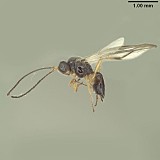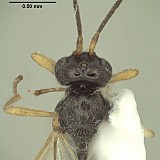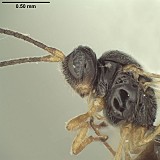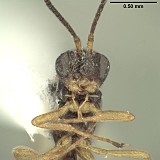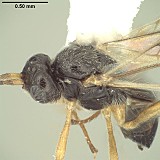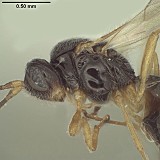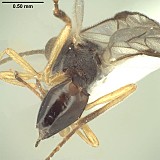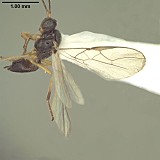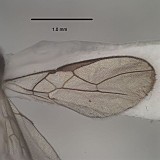Habitus (Fig. 1). Eyes in dorsal view (Fig. 2) very slightly bulging beyond temples, temples very weakly receding; eye about 1.5–1.7 x longer than temple in dorsal view; 2.3–2.5 x longer than temple in lateral view (Fig. 3). Face and vertex moderately to densely setose; frons bare. Clypeus (Fig. 4) tall, somewhat oval, 1.3 x broader than tall, ventral margin not protruding in lateral view, without horn or spine-like protrusions, sharp, convex in anterior view; labrum completely concealed. Malar space about equal to basal width of mandible, malar sulcus weak, not deeply incised. Mandible (Fig. 4) with dorsal margin not deflected, without basal lobe ventrally, apical teeth not twisted. Occipital carina absent middorsally, widely separated from hypostomal carina at base of mandible. Antenna with 19–21 flagellomeres; first flagellomere about 2.5–3.0 x longer than wide, 1.05–1.25 x length of second. Maxillary palp shorter than height of head. Mesosoma (Figs 5-7) 1.4 x longer than high, 1.95 x longer than wide, 1.4 x higher than wide. Pronotum dorsally narrow, with large pronope; laterally bare, polished, with well-developed vertical carina all along anterior margin of median vertical groove. Mesoscutum (Fig. 5) with anterior declivity about as in
O. taramegillae; notaulus and supramarginal carina completely absent; mesoscutum completely, uniformly densely covered with short, white, mostly decumbent setae; midpit absent. Precoxal sulcus distinctly though shallowly impressed, unsculptured (Fig. 6); extending from anterior margin in two specimens, confined to middle 0.3 of mesopleuron in third specimen, never reaching base of coxa. Metapleuron unsculptured medially, sparsely setose; median pit adjacent anterior margin and dorsal pit at posterior margin both relatively small, not connected by deep sulcus. Propodeal spiracle closer to anterior than posterior margin; propodeum (Fig. 7) sparsely setose, densely granular-rugulose throughout. Hind tibia without basal carina. Fore wing (Figs 8-9) with stigma narrowly wedge-shaped, merging imperceptibly with R1 distally, r arising from basal 0.3; 3RSa 1.4–1.5 x longer than 2RS, 2nd submarginal cell very strongly narrowing distally; 3RSb bowed, extending nearly to apex of wing; m-cu very widely antefurcal; 2CUb arising distinctly below middle of distal margin of 1st subdiscal cell, 1st subdiscal cell open apically, 2cu-a completely absent; 1cu-a weakly postfurcal; distance between anal vein and ventral wing margin slightly less than width of anal vein. Hind wing with RS and 2M equally developed as very weakly pigmented creases extending to wing margin, m-cu slightly weaker, extending at least 0.5 distance to wing margin. S1 short but visible, 0.15–0.2 x length of T1; T1 (Fig. 7) with laterope but without dorsope; largely smooth basally, striate over posterior 0.7; dorsal carinae distinct basally on either side of broad, shallow basal depression, usually extending nearly to posterior margin, less distinct posteriorly amongst striate sculpture; T1 0.9–1.1 x longer than apical width; apex 2.1–2.25 x wider than base. T2 and following terga unsculptured. Ovipositor (total length) approximately 0.8–0.9 x length of mesosoma; ovipositor sheath approximately 0.3–0.4 x length of mesosoma. Color (Figs 1-7): Dark brown, T2+3 light brown, tegula, clypeus, ventral margin of face from anterior tentorial pit through lower part of malar space, mandible (except apical teeth), palps, and most of legs yellow to very pale yellow; tarsi and apical 0.3–0.4 of hind tibia variously brown; wings hyaline. Body length 1.8–2.4 mm; wing length 2.6–2.7 mm; mesosoma length 0.95–0.75 mm.

